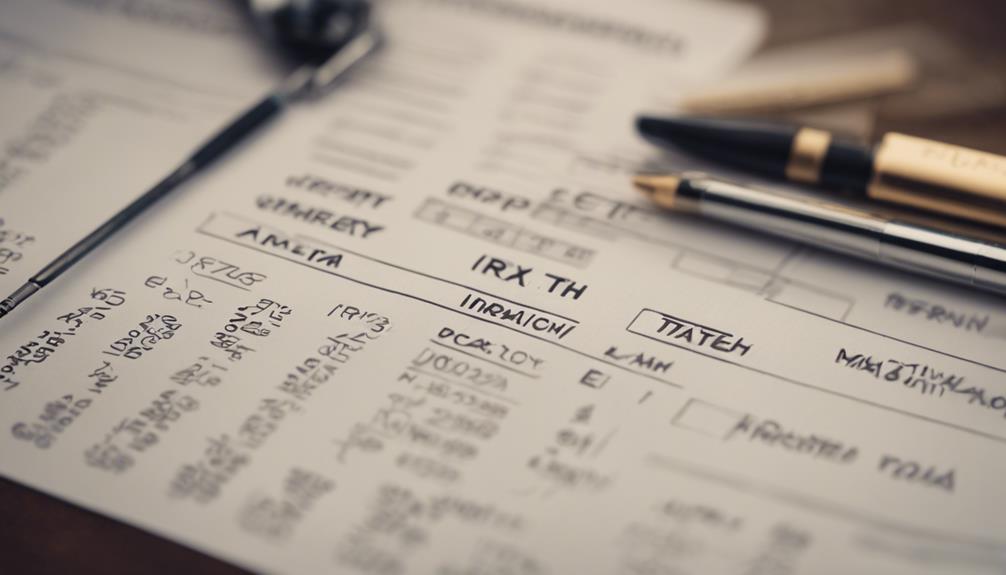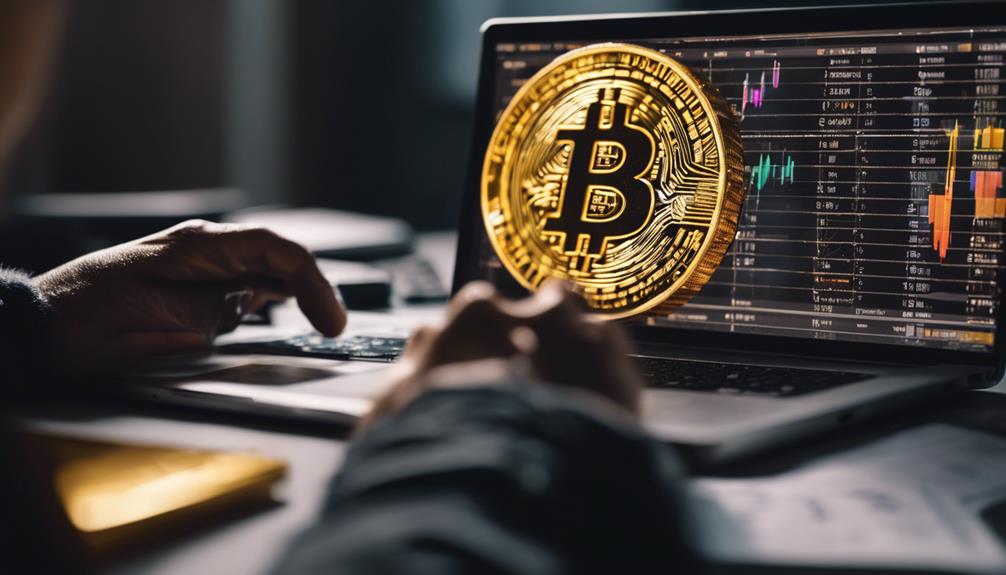When you are deciding between a tax-free IRA, it’s important to consider both Roth and Traditional options. The Roth IRA involves making post-tax contributions and allows for tax-free withdrawals. On the other hand, the Traditional IRA requires pre-tax contributions that are taxed as income when withdrawn. While Roth IRAs have no age limit, there are income limits for contributions. Both types of IRAs offer tax benefits, but the Roth IRA is more suitable for those who anticipate being in higher tax brackets in the future. One advantage of the Roth IRA is that it allows penalty-free early withdrawals, providing more flexibility. Understanding contribution limits is crucial for effective retirement planning. It’s important to assess your financial goals and expected income to choose the IRA that aligns best with your long-term objectives. To make an informed decision, learn more about Roth and Traditional IRAs.
Key Takeaways
- Consider a Roth IRA for tax-free withdrawals in retirement and no required minimum distributions.
- Evaluate your current and expected future income to determine eligibility for Roth IRA contributions.
- Choose a Roth IRA if you anticipate being in a higher tax bracket during retirement.
- Opt for a Roth IRA for flexibility in financial planning and diverse tax strategies.
- Assess your financial goals and align them with the benefits of a Roth IRA for long-term gains.
Roth Vs. Traditional IRA Comparison

When deciding between a Roth and a Traditional IRA, consider the tax implications for your retirement savings. Roth IRAs involve contributions with post-tax dollars, meaning you pay taxes on the money before it goes into the account. The advantage here is that when you make qualified withdrawals in retirement, you won't owe any taxes on those funds.
On the other hand, Traditional IRAs require contributions with pre-tax dollars, offering an immediate tax deduction. However, withdrawals from Traditional IRAs in retirement are taxed as regular income.
Roth IRAs have no age limit for contributions, making them accessible to individuals of any age who meet the income requirements. Traditional IRAs, on the other hand, have no age limit for account holders, but contributions can only be made until you reach 70½ years old. Your choice between Roth and Traditional IRAs should be based on your future income expectations and tax bracket projections, as this decision can have a significant impact on your retirement savings.
Eligibility and Contribution Limits

When considering an IRA, understanding the eligibility criteria and contribution limits is vital. For 2024, the annual contribution limit stands at $7,000, or $8,000 for individuals aged 50 and above.
Income limits may impact eligibility for Roth IRAs, so it's important to be aware of these factors when deciding on the best IRA option for your financial goals.
IRA Eligibility Criteria
Understanding the eligibility criteria and contribution limits for IRAs is crucial for effectively planning your retirement savings. When considering Roth IRA vs. Traditional IRA options for 2024, keep in mind:
- Roth IRA contributions have income limits for eligibility, while Traditional IRA contributions have no income limits.
- To contribute to a Roth IRA, you must have taxable compensation.
- Roth IRA contributions phase out at higher incomes based on filing status.
- Familiarize yourself with IRA contribution limits to make sure you stay eligible and make the most of your retirement savings strategy.
Understanding these distinctions will help you make informed decisions about which IRA best suits your financial situation.
Contribution Limit Considerations
To maximize your retirement savings potential, be mindful of the annual IRA contribution limit for 2024, set at $7,000 ($8,000 for individuals aged 50 and above). This limit applies to both traditional and Roth IRAs.
Additionally, consider factors like modified adjusted gross income for Roth IRA eligibility and deductible IRA contributions. If you're above 50, take advantage of catch-up contributions to boost your savings.
Be aware of withdrawal rules for both IRA types and explore options like backdoor Roth IRAs if applicable. Using an IRA Contribution Calculator can help you determine the best approach based on your financial situation.
Stay informed about IRA deduction rules and make informed decisions to secure your retirement funds effectively.
Tax Implications and Withdrawals

In retirement, the tax implications and withdrawal rules of Roth and Traditional IRAs greatly influence your financial planning decisions. Here are some key points worth taking into account:
- Tax-Free Withdrawals: Roth IRAs offer tax-free withdrawals in retirement, providing a valuable source of tax-free income.
- Income Tax Bracket: Traditional IRAs require withdrawals to be taxed as income in retirement, potentially affecting your income tax bracket.
- Early Withdrawal Penalty: Roth IRAs allow penalty-free early withdrawals of contributions for specific reasons, offering more flexibility compared to Traditional IRAs.
- Tax Diversification: By having both Roth and Traditional IRA accounts, you can achieve tax diversification, which can be advantageous when planning for withdrawals in retirement.
Understanding these factors can help you make informed decisions about which type of IRA aligns best with your retirement goals and financial situation.
Advantages of a Roth IRA

Roth IRAs provide tax-free withdrawals in retirement, offering a reliable income stream for your future. With contributions made using after-tax dollars, your money grows tax-free over time, maximizing your retirement savings potential.
Enjoy the flexibility of no required minimum distributions during your lifetime, giving you control over how and when you access your funds.
Tax-Free Withdrawals
Experience tax-free growth and withdrawals with a Roth IRA, offering significant advantages for retirement planning.
- Enjoy tax-free withdrawals of both contributions and earnings in retirement.
- Benefit from making contributions with after-tax dollars, allowing for tax-free growth.
- Avoid required minimum distributions during your lifetime, unlike traditional IRAs.
- Take advantage of Roth IRA withdrawals not being taxed as income in retirement, providing a significant tax advantage.
Roth IRAs are particularly beneficial for individuals anticipating a higher tax bracket in retirement, maximizing the tax-free benefits they offer. Consider the long-term advantages of tax-free withdrawals and the flexibility Roth IRAs provide for your retirement savings strategy.
No Age Restrictions
When considering retirement savings options, exploring a Roth IRA can offer significant advantages due to its lack of age restrictions for contributions. Roth IRAs allow individuals, regardless of age, to contribute as long as they've earned income. This feature makes them appealing for those who continue working past traditional retirement age, providing flexibility in retirement planning and potential long-term growth opportunities.
Younger investors, such as Millennials and Gen Z, can benefit greatly by starting Roth IRA contributions early to maximize tax-free growth potential. Additionally, investors seeking tax-free withdrawals in retirement without age limitations may find Roth IRAs to be the right choice for their financial goals. With Roth IRAs, you have the freedom to contribute at any age and enjoy the benefits of tax-free growth for your long-term financial security.
Considerations for Choosing an IRA

When deciding between a Roth IRA and a Traditional IRA, it's important to take into account your anticipated future income tax bracket. Consider the following factors to help you make an informed decision:
- Tax-Free Withdrawals: Roth IRAs offer tax-free withdrawals in retirement, providing you with the advantage of accessing your funds without additional tax implications.
- Tax Deductions: Traditional IRAs provide immediate tax deductions on contributions, which can lower your taxable income now. However, withdrawals from Traditional IRAs are taxed in retirement.
- Future Income: Evaluating your expected future income is essential. If you anticipate being in a higher tax bracket during retirement, a Roth IRA may be more beneficial due to its tax-free withdrawals.
- Financial Goals: Align your choice of IRA with your financial goals. Whether you prioritize immediate tax benefits or tax-free withdrawals in retirement, select the IRA that best suits your long-term objectives.
Expert Recommendations and Tips

For valuable insights on choosing the right tax-free IRA, experts recommend considering factors like your future income projections and desired tax benefits. When it comes to tax-free withdrawals and long-term growth potential, Roth IRAs are often the top choice. Experts frequently suggest Roth IRAs for Millennials and Gen Z individuals due to their unique benefits. These accounts operate similarly to investment accounts, offering tax advantages and no age restrictions for contributions.
On the other hand, traditional IRAs provide immediate tax deductions but function more like pensions, with taxable withdrawals during retirement. To make an informed decision, evaluate your future income expectations and tax brackets carefully. By understanding these key elements, you can determine which tax-free IRA aligns best with your financial goals and retirement plans.
Frequently Asked Questions
How Do I Know Which IRA Is Best for Me?
When determining the best IRA for you, assess your current income, future expectations, and tax preferences. Consider if you prefer paying taxes now (Roth IRA) or in retirement (Traditional IRA). Predict your retirement tax bracket to guide your choice.
Roth IRAs offer tax-free withdrawals in retirement, while Traditional IRAs provide immediate tax deductions. Evaluate the benefits of tax diversification and long-term growth to make an informed decision about your tax-free IRA selection.
Should I Have a Traditional and Roth Ira?
If you're considering whether to have a Traditional and Roth IRA, the answer lies in your financial goals.
A Traditional IRA can offer immediate tax benefits through deductible contributions, while a Roth IRA provides tax-free growth and withdrawals in retirement.
Balancing both can give you flexibility in managing tax implications. Evaluate your current and future tax situation to determine the right mix for your needs and retirement plans.
What Type of IRA Is Not Taxed?
A Roth IRA isn't taxed on withdrawals in retirement. Contributions are made with post-tax dollars, leading to tax-free distributions. Earnings and growth within a Roth IRA are also not subject to taxes.
Additionally, Roth IRAs don't have required minimum distributions during the original owner's lifetime, and they allow penalty-free withdrawals of contributions at any time. These features make Roth IRAs a tax-efficient retirement savings option.
Which IRA Fund to Choose?
When deciding which IRA fund to choose, consider your long-term goals and tax implications. A Roth IRA offers tax-free growth and withdrawals, making it ideal for those expecting higher taxes in retirement.
Meanwhile, a Traditional IRA provides tax-deferred growth but taxes withdrawals. Evaluate your future tax situation to determine the best fit. Assess your financial goals to make an informed decision between Roth and Traditional IRA funds.
Conclusion
To wrap up, when deliberating between a Roth IRA and a Traditional IRA, it's crucial to take into account your financial goals, current tax situation, and retirement plans.
Both options have their advantages and drawbacks, so it's vital to evaluate them carefully before making a decision. Seeking advice from a financial advisor can offer valuable insights and guidance tailored to your specific needs.
Keep in mind, the optimal choice for you'll hinge on your individual circumstances and long-term objectives.
Helen brings a wealth of experience in investment strategy and a deep passion for helping individuals achieve their retirement goals. With a keen understanding of market dynamics, Helen has been instrumental in shaping the vision and direction of Gold IRA Markets. She specializes in creating innovative solutions that align with our clients’ long-term investment objectives.










